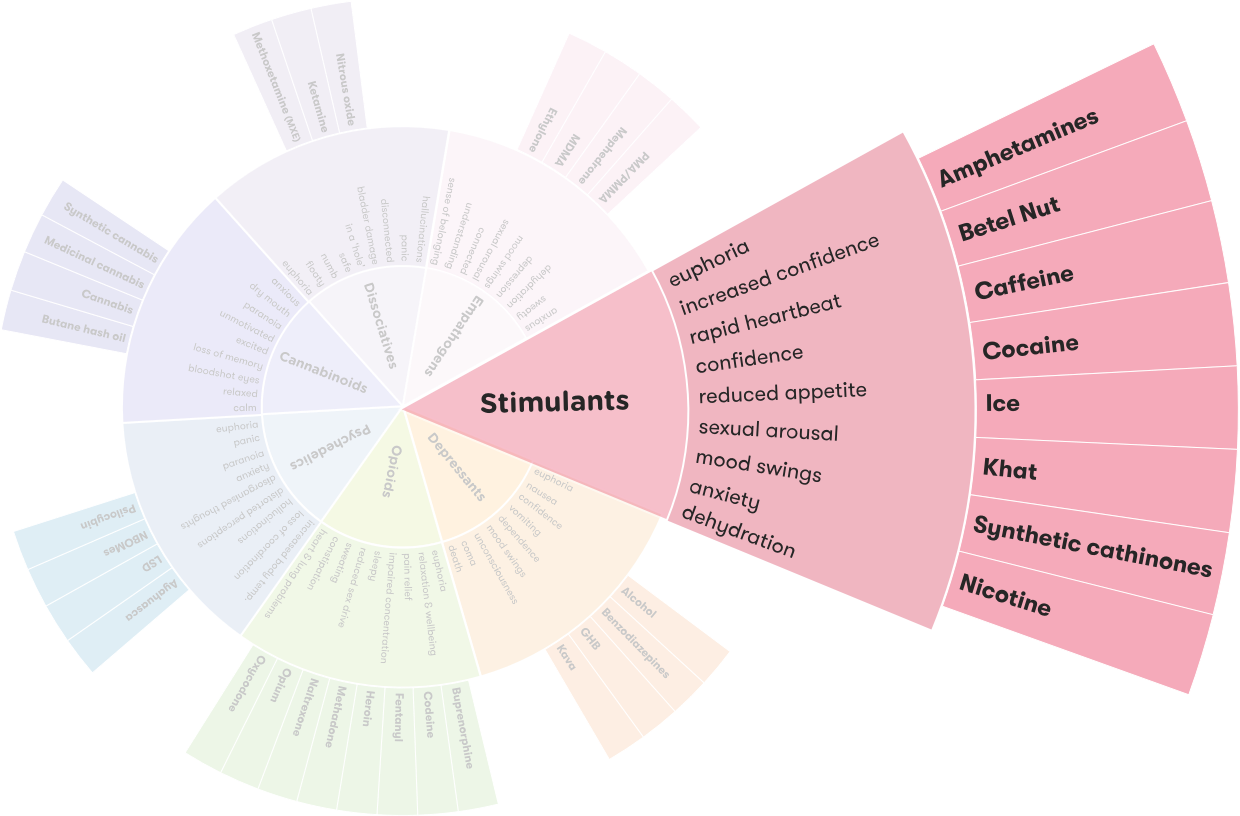Stimulants are drugs that have the effect of increasing alertness, concentration, and energy. They are often used to treat various medical conditions, and have been around for centuries. But what types of drugs are stimulants, and what are the potential benefits and risks associated with taking them? In this article, we’ll explore the many different types of stimulants and the associated risks and benefits they can provide.

What are Stimulants?
Stimulants are drugs that increase alertness, attention, and energy, elevating reaction time and the ability to concentrate. They also increase heart rate and blood pressure, and can produce feelings of excitement and euphoria. Stimulants are used to treat certain medical conditions such as narcolepsy and attention deficit hyperactivity disorder (ADHD). However, they are also abused recreationally due to their ability to produce euphoria, increase energy, and reduce fatigue.
Stimulants can be found naturally occurring in foods, plants, and animals, and can also be synthesized in a laboratory. The most commonly abused stimulants include amphetamines, cocaine, and caffeine.
Amphetamines
Amphetamines are synthetic stimulants that produce alertness, increased energy, and euphoria. They are used medically to treat attention deficit hyperactivity disorder (ADHD) and narcolepsy. The most commonly abused amphetamines are Adderall, Ritalin, and Dexedrine. Amphetamines are highly addictive and can cause serious health complications, such as cardiovascular and neurological problems.
Prescription Amphetamines
Prescription amphetamines are those that are prescribed by a doctor and dispensed through a pharmacy. Adderall and Ritalin are two of the most commonly prescribed amphetamines. They are both used to treat attention deficit hyperactivity disorder (ADHD). These drugs can be addictive, and can cause serious side effects including insomnia, anxiety, and agitation.
Illicit Amphetamines
Illicit amphetamines are those that are not prescribed by a doctor and are obtained through illegal means. Methamphetamine is the most commonly abused illicit amphetamine. It is a powerful stimulant that can cause dangerous physical and psychological side effects, such as psychosis and aggression.
Cocaine
Cocaine is an extremely addictive stimulant drug derived from the coca plant. It is a powerful stimulant that produces intense feelings of euphoria and energy. Cocaine is usually snorted, injected, or smoked, and can cause dangerous physical and psychological side effects. These can include increased heart rate and blood pressure, paranoia, and seizures.
Powdered Cocaine
Powdered cocaine is the most common form of cocaine. It is usually snorted or injected. It produces a powerful but short-lived high that can be highly addictive. It can cause serious physical side effects including cardiovascular and respiratory problems.
Crack Cocaine
Crack cocaine is a form of cocaine that has been processed with baking soda or ammonia. It is usually smoked and produces a short-lived, intense high that can be highly addictive. It can cause serious physical and psychological side effects, such as paranoia and anxiety.
Caffeine
Caffeine is a naturally occurring stimulant found in coffee, tea, energy drinks, and cocoa. It is the most widely consumed psychoactive substance in the world. Caffeine produces alertness, increased energy, and improved cognitive performance. It can also cause physical and psychological side effects, such as jitteriness, anxiety, and insomnia.
Related Faq
What Are Stimulants?
Stimulants are a class of drugs that act on the central nervous system to increase activity, alertness, and energy levels. Common stimulants include caffeine, amphetamines, cocaine, and nicotine. Stimulants can be used for legitimate medical reasons, such as treating attention deficit hyperactivity disorder (ADHD), narcolepsy, and obesity, but they are also frequently abused for their ability to provide an intense rush of energy and euphoria.
What Are the Different Types of Stimulants?
The three main types of stimulants are amphetamines, cocaine, and nicotine. Amphetamines are a type of synthetic drug that has been used medically to treat a variety of conditions, including ADHD and narcolepsy. Cocaine is a powerful stimulant derived from the coca plant, and nicotine is an additive found in cigarettes and other tobacco products. Other less commonly used stimulants include methylphenidate, ephedrine, and 3,4-methylenedioxymethamphetamine (MDMA).
What Are the Effects of Stimulants?
The effects of stimulants vary depending on the type and dose of the drug. Generally, stimulants produce feelings of euphoria, increased energy, and alertness. They can also cause increased heart rate, blood pressure, and respiration. In addition, stimulants can lead to insomnia, loss of appetite, and paranoia. Prolonged use of stimulants can lead to addiction and potentially life-threatening overdose.
Are Stimulants Dangerous?
Yes, stimulants can be dangerous when misused or abused. Stimulants can lead to physical dependence and addiction, and they can have serious physical and mental health effects. Stimulant abuse can also lead to serious health complications, including heart attack, stroke, and even death.
What Are the Signs of Stimulant Abuse?
The signs of stimulant abuse can vary depending on the type and amount of the drug used. Common signs and symptoms of stimulant abuse include increased energy, alertness, and euphoria; increased heart rate and blood pressure; insomnia; weight loss; and paranoia. Other signs of stimulant abuse can include aggressive behavior, anxiety, and psychosis.
What Is the Treatment for Stimulant Abuse?
The treatment for stimulant abuse typically involves a combination of medication, psychotherapy, and lifestyle changes. Medication can be used to help reduce cravings and withdrawal symptoms. Psychotherapy can help individuals identify and address the underlying causes of their stimulant abuse and develop healthy coping skills. Lifestyle changes can include exercise, healthy eating, and avoiding triggers that can lead to relapse.
Psychoactive drugs: Stimulants | Processing the Environment | MCAT | Khan Academy
In conclusion, stimulant drugs are powerful substances that can drastically affect the body and mind. Although they can provide short-term benefits, they can also come with serious risks and side effects. It is important to understand the potential dangers of stimulants and to take them only as prescribed by a doctor. When used responsibly and under the guidance of a medical professional, stimulants can be an effective way to address medical conditions and improve productivity.

